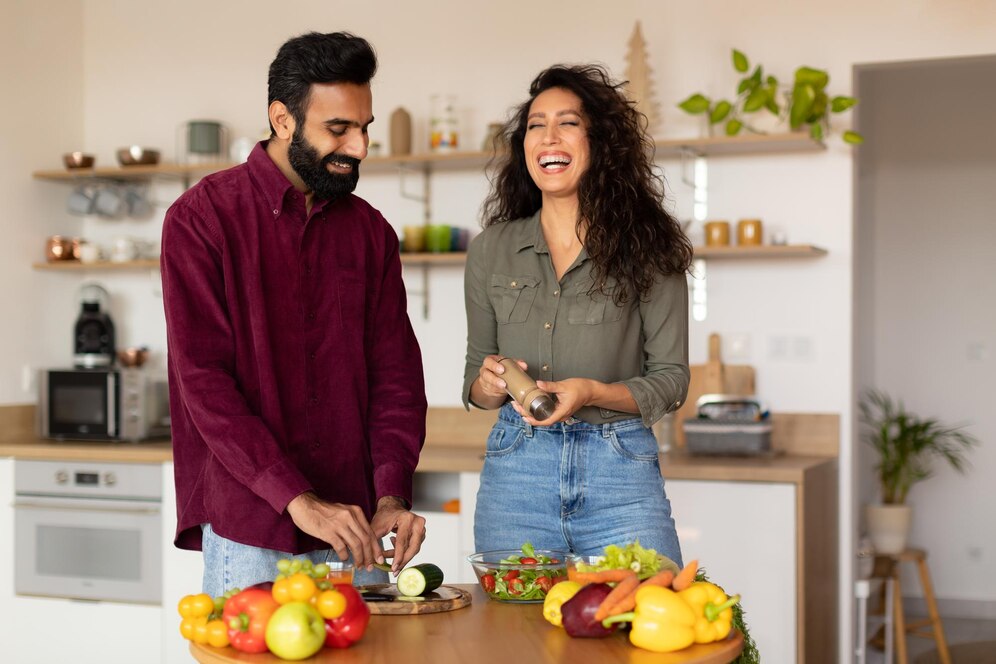Contents
- 1 Simple Ways to Get More Fruits and Vegetables into Your Diet
- 1.1 Questions and Answers About Eating More Fruits and Vegetables
- 1.1.1 1. How many servings of fruits and vegetables should I eat every day?
- 1.1.2 2. Is it okay to use frozen fruits and vegetables instead of fresh?
- 1.1.3 3. What if I don’t like eating raw veggies?
- 1.1.4 4. Can you use fruit juices instead of whole fruits?
- 1.1.5 5. How can I get kids to eat more fruits and veggies?
- 1.1.6 6. Plan meals that include more vegetables
- 1.1.7 7. How to eat more fruits and vegetables without spending too much money
- 1.1.8 8. How to start eating vegetables when you don’t like them
- 1.1.9 9. Best way to get vegetables without eating them
- 1.1.10 10. A 7-day plan for eating fruits and vegetables
- 1.1.11 11. How to eat fruits and vegetables when you don’t like them
- 1.1.12 12. Eating more fruits and vegetables to lose weight
- 1.1.13 13. How to eat more vegetables without having to eat salad
- 1.2 Related Articles
- 1.1 Questions and Answers About Eating More Fruits and Vegetables
Simple Ways to Get More Fruits and Vegetables into Your Diet
You don’t have to feel like eating fruits and vegetables every day is a chore. It’s not about giving up your favorite foods; it’s about making your meals more colorful, crunchy, and healthy in easy ways. Even the busiest person can easily improve their meals with a little planning.
Begin with the first meal of the day
Breakfast is a great time to sneak in some fruits and vegetables. Do you love toast? Add avocado, tomato slices, or banana with a drizzle of honey on top. Smoothies are another quick fix. Just blend spinach, frozen berries, or mango chunks for a tasty and healthy start. Mix finely grated vegetables like beetroot or carrot into poha or upma for an Indian touch.
Need some ideas for recipes? Visit Tarla Dalal for traditional recipes that make fruits and vegetables shine.
Choose colorful snacks to be smart
Snacking is a time when healthy habits often go wrong. Store cut-up apples, carrots, or cucumbers in the fridge. You can eat them with hummus, peanut butter, or a sprinkle of chaat masala. Roasted veggie chips are a crunchy snack that isn’t processed.
Online stores like BigBasket sell pre-cut fruits and fresh salad packs that make snacking healthier and save time.
Make Your Favorite Recipes Better
You don’t have to eat boring salads to get more vegetables. Add spinach to dals, pumpkin or beans to sabzi, and stack vegetables like lettuce, onions, bell peppers, and tomatoes in sandwiches or wraps. When you mix carrots, zucchini, or mushrooms into pasta sauces, they become healthier.
Check out Hebbars Kitchen for Indian-style recipes that are easy to make and full of vegetables.
Make It Look Good, Eat More of It
Our eyes are the first thing we use to eat. Eating colorful, bright meals makes you want to eat better. You can make a stir-fry or pulao with red peppers, green peas, orange carrots, and yellow corn. Instead of always blending fruits like mango, kiwi, or berries, put them in a bowl. Nutritionists and food bloggers on Instagram post a lot of ideas for dishes that look good.
One Small Change at a Time
You don’t have to change your whole diet right away. Add one piece of fruit to your lunchbox or one vegetable to your dinner to get started. When you’re short on time, frozen fruits and pre-cut vegetables can save your life. You can keep track of what you eat and be aware of your nutrition with apps like MyFitnessPal.
Must read: 7 Surprising Facts About Your Favorite Fruits
Questions and Answers About Eating More Fruits and Vegetables
1. How many servings of fruits and vegetables should I eat every day?
People often say to eat at least 5 servings of fruits and vegetables every day. This usually means eating two servings of fruit and three servings of vegetables, but if you have time, you can eat more. A serving is about half a cup of cooked vegetables or one whole fruit, like an apple, banana, or orange.
Be careful if you’re blending or juicing fruits. Try to only have one serving of fruit per drink to avoid getting too much sugar all at once. But you can often blend or juice more vegetables at once because they are naturally low in sugar and high in nutrients. Eating foods that are green, red, yellow, orange, and purple makes sure you get a good mix of vitamins, minerals, and antioxidants.
2. Is it okay to use frozen fruits and vegetables instead of fresh?
Yes! Frozen fruits and vegetables have the same nutrients as fresh ones. They are usually frozen when they are at their best ripeness, which keeps most of their vitamins and minerals. Frozen fruits and vegetables are also easy to use because they can be stored for months without going bad.
When you buy frozen fruits and vegetables, make sure to check the labels for added sugar, salt, or sauces. Frozen peas, carrots, and corn are great for stir-fries, curries, and pulao, for instance. Frozen berries, mangoes, or banana chunks are great for smoothies because they naturally cool the drink and cut down on prep time. Using frozen fruits and vegetables can also help you save money because they are usually cheaper than fresh ones, especially when they are out of season.
3. What if I don’t like eating raw veggies?
You don’t have to eat raw vegetables to get the benefits. Cooking vegetables can actually make them taste better and sometimes make more nutrients available. Use as little oil as possible and some herbs or spices to steam, sauté, roast, or lightly stir-fry your vegetables.
Another easy way to eat more is to add vegetables to your favorite meals:
- Add grated carrot or spinach to dals or curries.
- Add mushrooms, zucchini, or bell peppers to pasta sauces.
- Add shredded lettuce, cabbage, or carrots to wraps and sandwiches.
You can find a way to enjoy vegetables without eating them raw by trying out different cooking methods and flavors.
4. Can you use fruit juices instead of whole fruits?
Not really. Whole fruits are always a better choice because they have fiber, which helps with digestion and keeps you full longer. A lot of the time, packaged fruit juices have added sugar and less fiber, which can make blood sugar levels go up.
If you like juice, you should make it at home with a blender. Keep the pulp to keep the fiber and nutrients. One small glass of fresh juice a day is fine, but you should eat whole fruits instead for the best health benefits. Smoothies are a good compromise because they keep the fiber and give you a refreshing drink at the same time.
5. How can I get kids to eat more fruits and veggies?
It can be hard to get kids to eat fruits and vegetables, but there are fun and creative ways to encourage healthy habits:
- Make fruits and vegetables into fun shapes or colorful sticks.
- Use spinach or carrots to make smoothies that are good for you.
- Put veggies in your favorite foods, like parathas, pancakes, or pasta.
- Let kids help make meals so they will be excited to eat what they helped make.
Kids are more likely to eat fruits and vegetables regularly if they look good and are fun to eat.
6. Plan meals that include more vegetables
One easy way to get more vegetables into your diet is to spread them out over all your meals. Add vegetables to your omelets, upma, or poha for breakfast. A side salad, a vegetable wrap, or stir-fried vegetables would be great for lunch. You can have raw vegetable sticks, roasted veggie chips, or fruit slices as snacks. You can have stir-fries, sabzi, or roasted vegetables with grains or lentils for dinner.
Consistency is key. Eating small amounts of vegetables every day adds up, and over time, it becomes second nature.
7. How to eat more fruits and vegetables without spending too much money
It doesn’t have to cost a lot to eat healthy. Here are some tips that won’t cost you much:
- Buy seasonal fruits and vegetables because they are cheaper and fresher.
- Choose frozen fruits and vegetables because they are cheap and last a long time.
- When you can, shop at local markets instead of supermarkets.
- Buy in bulk and prep in advance by cutting up and freezing portions.
Carrots, cabbage, bananas, and spinach are all good for you and don’t cost much.
8. How to start eating vegetables when you don’t like them
You don’t have to stay away from vegetables just because you don’t like them. Begin with small steps:
- Add small amounts to foods you already like. Mix vegetables into soups, smoothies, or sauces.
- Roast or season them with spices to make them taste better.
Your taste buds get used to it over time, and vegetables taste better. The most important things are consistency and trying new things.
9. Best way to get vegetables without eating them
You can still get the benefits of vegetables even if you really don’t like them by hiding them in other foods:
- Put grated or pureed vegetables into soups, sauces, stews, or baked goods.
- Add spinach, carrots, or zucchini to pancakes, muffins, or smoothie bowls.
This way, you can get the nutrients you need without having to chew on raw or cooked vegetables separately.
10. A 7-day plan for eating fruits and vegetables
Here’s a simple 7-day plan to get you to eat every day:
- Day 1: Spinach omelet and an apple; a veggie wrap; carrot sticks; and a stir-fry with rice and mixed vegetables.
- Day 2: A banana-spinach smoothie; lentil vegetable soup; sliced cucumber and peppers; and roasted pumpkin and beans.
- Day 3: Poha with grated carrots and peas; a mixed salad; apple slices; and vegetable pulao.
- Day 4: Oatmeal with mango and berries, chickpea salad, roasted veggie chips, and spinach and mushroom curry.
- Day 5: A smoothie made with carrots and beets, a vegetable sandwich, papaya slices, and a stir-fry with broccoli and beans.
- Day 6: Upma with vegetables, lentil vegetable stew, celery sticks with peanut butter, and mixed sabzi with chapati.
- Day 7: Yogurt with berries, quinoa salad with bell peppers and corn, apple slices, and a mix of roasted vegetables.
This plan is easy to follow, colorful, and flexible, so you can get a lot of different foods and nutrients.
11. How to eat fruits and vegetables when you don’t like them
If you don’t like fruits and vegetables, try hiding them in drinks or dishes:
- Mix vegetables into sauces, pancakes, or muffins. Add fruits to smoothies, oatmeal, or yogurt.
- Add tasty herbs and spices to your vegetables when you cook them.
Taste changes over time, and the secret is to slowly introduce new flavors and try different ones.
12. Eating more fruits and vegetables to lose weight
Fruits and vegetables are great for weight management because they are low in calories and high in fiber:
- Swap out high-calorie snacks for raw or cooked vegetables.
- Add more vegetables to meals to make them more filling.
- For better fullness, eat fruits and vegetables with protein.
This helps you eat fewer calories overall while still getting the nutrients you need.
13. How to eat more vegetables without having to eat salad
You can get vegetables in other ways besides salads:
- Add them to soups, curries, stir-fries, pasta, wraps, or baked goods.
- Roast, grill, or steam vegetables to make a tasty side dish.
- Add vegetables to sauces, soups, or smoothies.
Not just salads, but also variety and flavor should be the focus.





